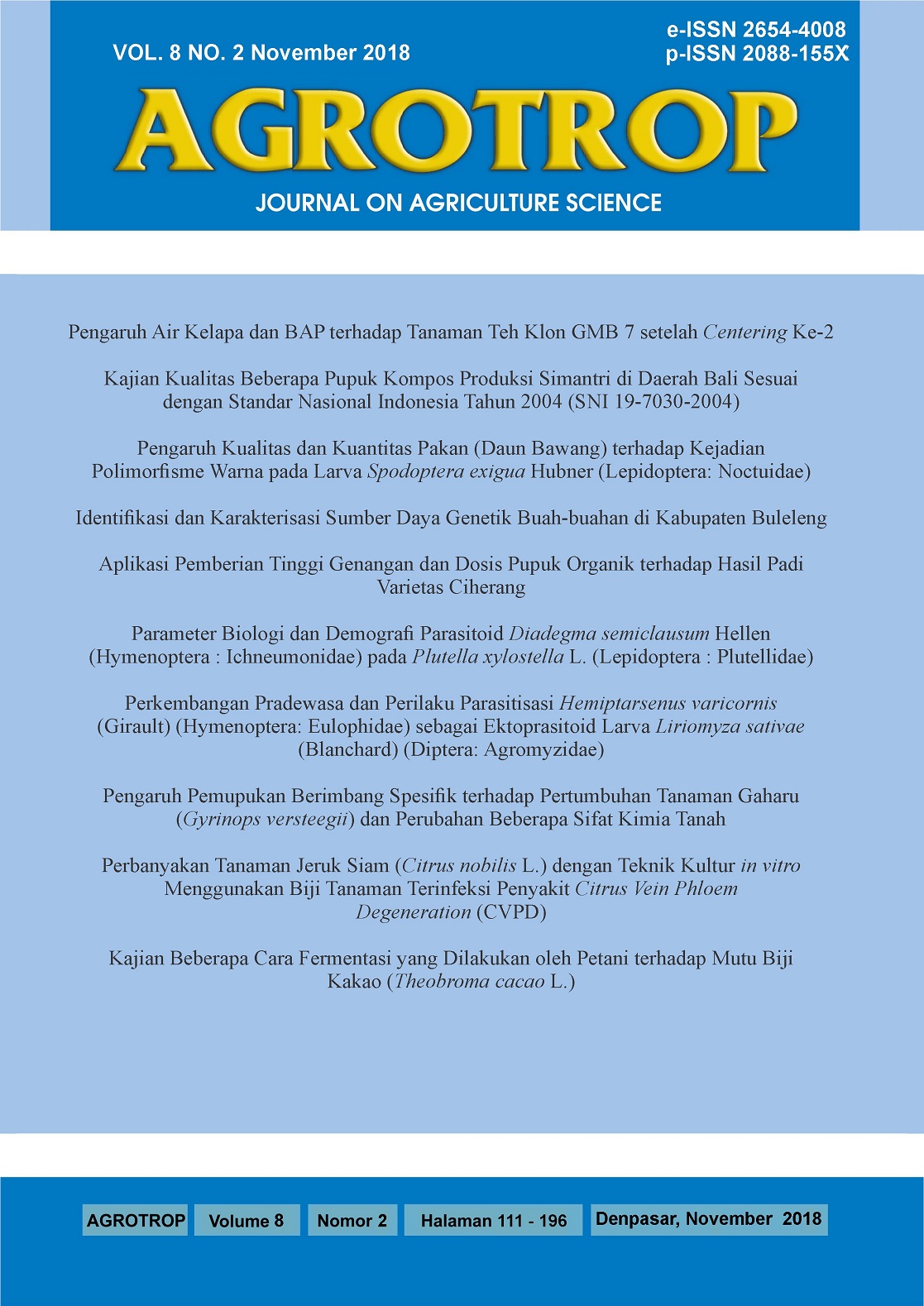Kajian Kualitas Beberapa Pupuk Kompos Produksi Simantri di Daerah Bali Sesuai dengan Standar Nasional Indonesia Tahun 2004 (SNI 19-7030-2004)
Abstract
Study of the Quality of Some Compost Fertilizer Simantri Production in Bali in Accordance with Indonesian National Standard-2004 (SNI 19-7030-2004). In Bali currently has circulated various types of compost, but testing of the quality most have not done regularly. Efforts to protect the consumer need to be implemented through the compost quality testing in the laboratory. This is done to prevent counterfeiting and ensure the quality of the compost is already in line with the quality standard SNI-2004. Among compost circulating in Bali, is compost Gapoktan Simantri production. The purpose of this study is to determine some of the physical and chemical properties of some Simantri’s compost circulating in Bali, whether in accordance with the criteria of the quality of compost SNI 19-7030-2004. Compost quality standards SNI-2004 are water content (<50%), pH (6.8 to 7.49), total-N (> 0.4%), C-organic (9.80 to 32%), P2O5 (> 0.10%), K2O (> 0.20%), C / N ratio (10-20), organic matter (27-58%), smells like soil, blackish color, and the temperature not hot. Compost sampling method for testing a composite on Gapoktan Simantri in Bali as many as 20 samples of compost. Parameters include: water content (grafimetri), pH (electrode glas), total-N (method of Kjeldhal), P2O5 and K2O (method of extracting HCL 25%), organic C (method of Walkley and Black), material organic, EC (coductometer), C/N ratio, color, temperature, and smell of the compost. Data obtained from the analysis in laboratory are compared to standard quality of compost according to SNI 19-7030-2004. The results showed that the total-N of compost Simantri is very high (1.13 to 2.11%), P content is very high (0.103 to 0.123%), K content is very high (0.902 to 2.342%), C-organic is very high (14.08 to 25.48%), C/N ratio (10.52 to 18.52), organic matter (24.87 to 43.93%) (all of these parameters in accordance with SNI-2004) ; pH (6.65 to 8.36) (some not suitable SNI-2004), EC (2.31 to 8.46 mmhos/cm2) (some very high), moisture content (36.60 to 56.60%) (some not suitable SNI-2004), blackish color, smells like soil, and temperature not hot (according to the standard SNI-2004).The majority (57.14%) of compost Simantri examined in accordance with the standard quality compost SNI-2004, but (42.86%) is not in accordance (pH and water content of compost).
Downloads
References
Harada Y. 1990. Composting and Application of Animal Waste. ASPAC. Food and Fertilizer Technology Center. Extension Bulletin No 311 : 20 – 31.
Isroi dan N. Yuliarti. 2009. Kompos. Penerbit Andi, Yogyakarta. 37 h.
Murbandono, L. 2009. Membuat Kompos. Penebar Swadaya, Jakarta. 36 h.
Novizan, 2005. Petunjuk Pemupukan Yang Efektif. Agromedia Pustaka, Jakarta. 34h.
Outerbridge,T.B. 1991. Limbah Padat di Indonesia. Yayasan Obor Indonesia. Jakarta. 31 h.
Simanungkalit, R.D.M., Suriadikarta, D.A., Saraswati, R., Setyorini, D dan W. Hartatik., 2006. Pupuk Organik dan Pupuk Hayati. Balai Besar Penelitian dan Pengembangan Sumberdaya Lahan Pertanian. Bogor. http://balittanah.litbang.deptan.go.id/ Diakses tanggal 4 Februari 2015. 36 h.
Suriadikarta, A.D., D. Setyorini & W. Hartatik.2006. Petunjuk Teknis Uji Mutu dan Efektivitas Alternatif Anorganik & Baku Mutu Pupuk Organik. Balai Penelitian Tanah, Puslitbangtanah Badan Penelitian dan Pengembangan Pertanian. Bogor.21 h.
Sugito, Y. 2005. Sistem Pertanian Berkelanjutan di Indonesia, Potensi dan Kendalanya. Bagpro PKSDM Ditjen Dikti Depdiknas kerjasama dengan Fakultas Pertanian Universitas Brawijaya, Malang. 23 h.
Sutedjo, M.M.,A.G. Kartasapoetra, dan Rd. S. Sastroatmodjo. 1996. Mikrobiologi Tanah. PT. Rhineka Cipta Pemupukan Cetakan ke 6 Penerbit PT Rineka Cipta. Jakarta. Hal 56-57
Stofella, P.J & Brian A. Khan, 2001. Compost Utilization in Holticultural Croping Systems. Lewis Publishers. USA. 17 h.
Syekhfani. 2005. Peranan Bahan Organik Dalam Mempertahankan Kesuburan Tanah. Bagpro PKSDM Ditjen Dikti Depdiknas kerjasama dengan Fakultas Pertanian Universitas Brawijaya, Malang. 9 h.
Tan, K. H. Dasar-Dasar Kimia Tanah. Gajah Mada University Press. Yogyakarta. 295 h.
Tantri, T.P.T.N, Supadma, A.A.N., D.W.M. Arthagama. 2016. Uji Kualitas Beberapa Pupuk Kompos yang Beredar di Kota Denpasar. E-J. Agroekoteknologi Tropika. Vol.5, No. 1. Hal. 52-62.











